By P.V. Akshay
In the vibrant and renowned bazaar of Bylakuppe, one of India’s oldest and largest Tibetan Settlements, the bustling streets are home to exquisite shops dedicated to Thangka, traditional Tibetan Buddhist paintings.
Visitors can witness the meticulous work of Thangka painters, each immersed in their artistic endeavours. They continue their centuries-old tradition and meticulously sketch the images of Gods and Goddesses on canvas, embodying the dedication and craftsmanship that define the art of Thangka painting.
Thangka, derived from the Tibetan words ‘than’ meaning flat and ‘ka’ meaning painting, is a traditional art form that originated in Nepal and was later exported to Tibet. The art’s roots can be traced back to the Seventh Century and has been handed down through generations.
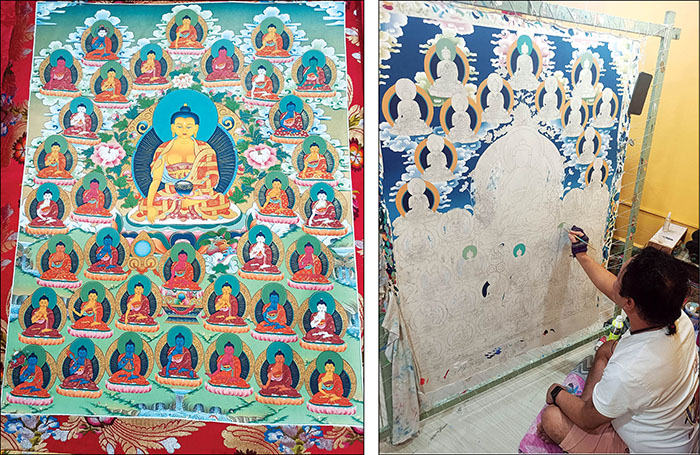
Thangka is a sophisticated three-dimensional masterpiece, featuring a painted or embroidered picture panel on silk or cotton textile. Its creation demands the artist’s precise understanding of the measurements and proportions specific to each deity, as dictated by Buddhist iconography.
These paintings elevate beyond being mere colourful wall hangings as they embody divine beauty. Executed on a flat surface, they possess the practicality of being rolled up like a scroll when not on display. What sets them apart is their longevity. They do not fade with time.
Thangka paintings skilfully depict the life of Buddha and other deities, weaving narratives around mythological events. Devotees employ these devotional Thangka paintings in ceremonies and prayer rituals. Significantly, beyond their religious context, these artworks function as powerful meditation tools, aiding individuals on their journey towards enlightenment.
In Buddhism, there is a belief in the divine presence in everything, encompassing natural occurrences and human actions, as well as the various stages of human life — from infancy to death. Each stage of life and every human act is associated with a God or Goddess. For instance, childhood, education, job, marriage, house building and more are all represented by deities depicted in Thangka paintings. Before embarking on or achieving various life milestones, Buddhists turn to these paintings, praying for divine intervention and the successful outcome of their endeavours. Thangka art becomes a medium through which individuals seek blessings and well-being for the significant stages in their lives.
In earlier times, artists utilised natural and vegetable colours for Thangka paintings. However, due to the scarcity of these colours and labour-intensive process of obtaining them, contemporary Thangka artists now use ready-made paints and shades.
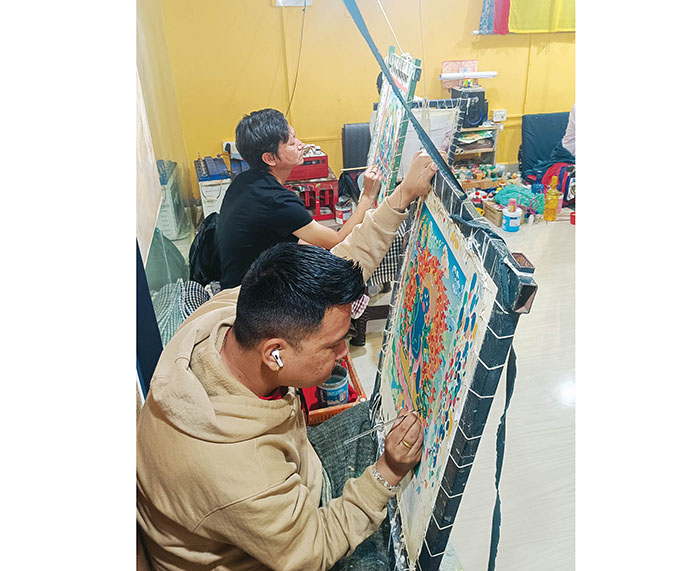
Scroll and long-lasting
Thangka is designed to be foldable, a practical feature for Tibetans who often travel, particularly monks in perpetual motion. The paintings boast exquisite art in the centre, while the sides and back are adorned with pure Banaras Silk.
Cloth borders envelop the sides and the top and bottom of the painting feature sticks for easy rolling or scrolling. Despite their delicate nature, these scroll paintings can endure for many years without fading.
There exist various types of Thangka paintings, all crafted on a made-to-order basis. In Bylakuppe, the history of Thangka paintings spans 30 to 40 years and it hosts over three to four outlets specialising in Thangka art, employing nearly 50 skilled Thangka painters.
Thangka artists undergo rigorous five-year training and attain proficiency at the Thangka School of Painting, operating across various locations in Himachal Pradesh, Ladakh and Dharamshala.
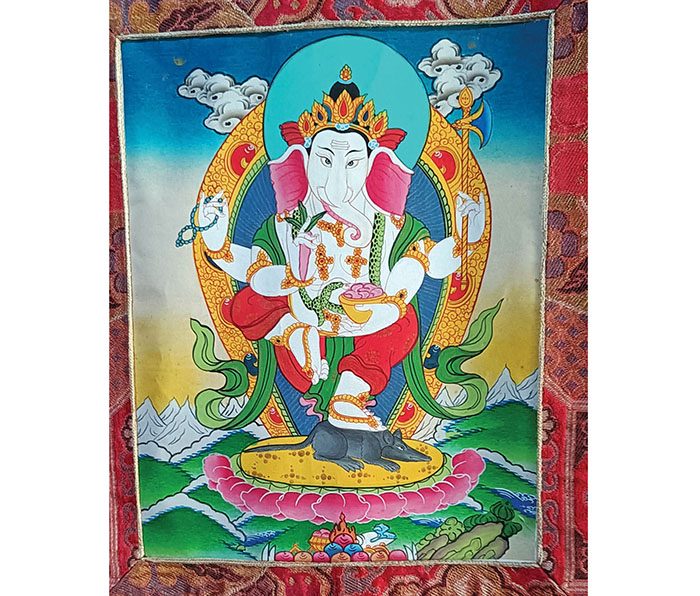
As per strict norms
Precision is paramount, as each God, Goddess or Buddhist symbol must be drawn in specific dimensions, adhering strictly to established traditions and beliefs. The dimensions, colours and shades are set with meticulous attention to detail and there are stringent rules governing every aspect of the paintings — each colour holds a specific meaning and every shade carries significance, leaving no room for deviation.
Thangka paintings vary in size, with the smallest measuring 15×18 inches at the Bylakuppe Tibetan Camp, while the largest can reach 30×50 feet or more.
Thangka paintings are not merely random creations; they are intricately linked to kundalini and astrological constellations, as well as the significance of families during a child’s birth. The size of a Thangka painting is determined by the financial capacity of the individual and the duration of prayers or meditation — whether short-term or long-term. Some Thangka paintings are revered and worshipped throughout an individual’s lifetime.
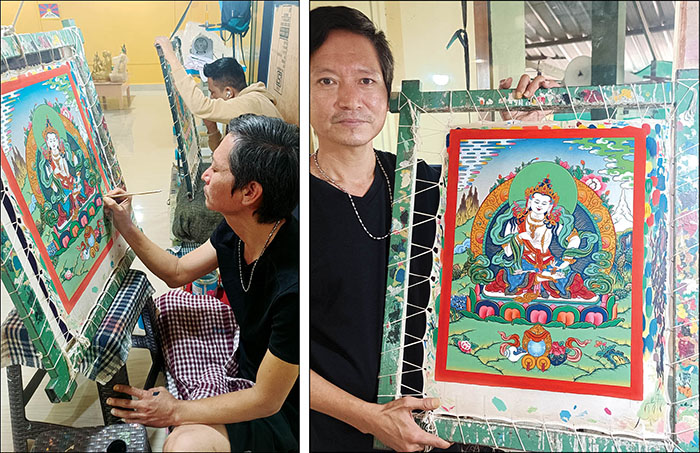
Creation process
The creation of a Thangka painting involves meticulous steps based on the order size. Initially, cotton and soft cloth are selected as the base for the scroll painting, which is then prepared with gum and paint distemper. The depiction of the worshipping God follows, adhering to traditional models.
Artists maintain an extensive collection of models representing various Gods and the preparation of even a small, single painting requires three to four days. For larger paintings with multiple images and intricate details, the process can extend to a minimum of 40 days.
Prices for Thangka paintings range from Rs. 5,000 for smaller sizes to Rs. 5 lakh, with variations based on specific requirements, the deities to be depicted and the intricacies involved. The artistry involves intricate detailing, incorporating minute and colourful aspects.
Painters ensure precision in colour and shade combinations, leaving no room for errors. Creating a Thangka is akin to penance, demanding utmost precision in every element of the painting.
Upon completion, a ‘mantra’ to propitiate or appease the specific God depicted is written on the back of the painting. The back side is then carefully stitched with pure Banaras Silk cloth, sourced from Banaras. This meticulous process ensures longevity and resistance. The final product is not just a piece of art but a sacred representation infused with tradition, precision and devotion.
Sam Ten, the owner of Sam Ten Arts, has dedicated 34 years to the practice of Thangka paintings, showcasing his extensive experience in this traditional art form. He acquired his skills from his Guru and for the past 28 years, Sam Ten has been independently creating these intricate artworks.
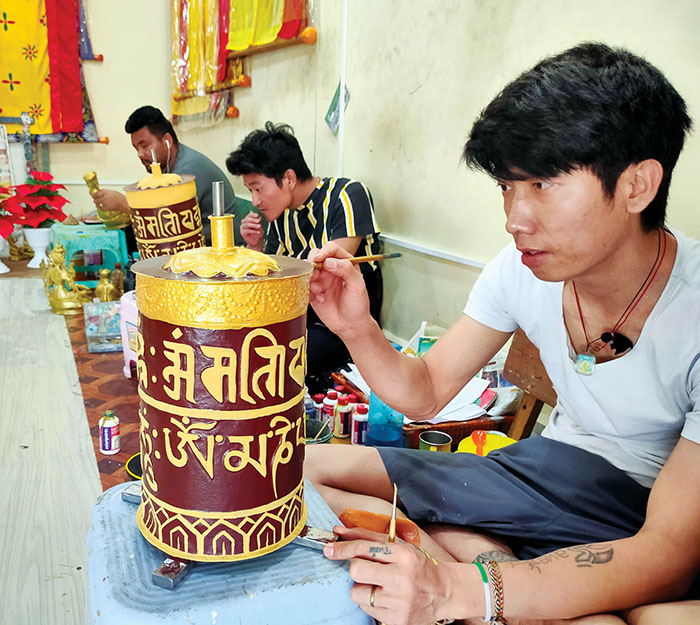
Dedicated work for months
“We are offering a service as the paintings bring good tidings to those who pray and their families will prosper,” Sam Ten said. A notable aspect is that a significant portion, 75 to 80 percent, of the earnings from the sale goes directly to the artists. The artisans invest focused and dedicated work on each piece of art, which may take anywhere from four days to up to 40 days or even three months.
It is important to note that Thangka is not restricted to Buddhism or Tibetan culture alone. Artists like Sam Ten depict Hindu Gods such as Lord Ganesha, showcasing a beautiful concept of religious harmony within this versatile art form.



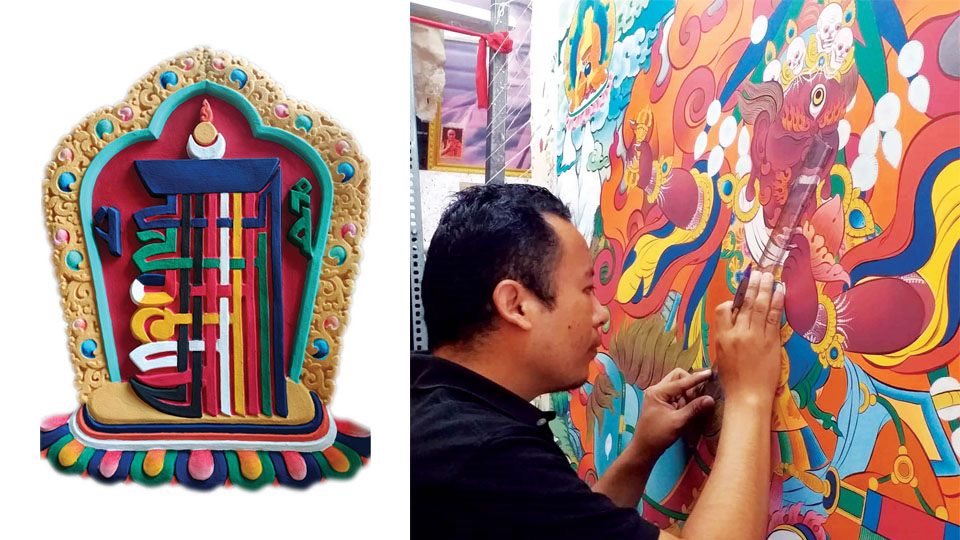




Recent Comments